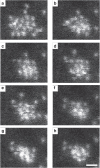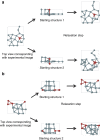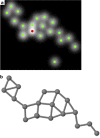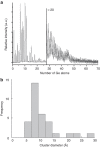Atomic scale dynamics of ultrasmall germanium clusters
- PMID: 22692540
- PMCID: PMC3621408
- DOI: 10.1038/ncomms1887
Atomic scale dynamics of ultrasmall germanium clusters
Abstract
Starting from the gas phase, small clusters can be produced and deposited with huge flexibility with regard to composition, materials choice and cluster size. Despite many advances in experimental characterization, a detailed morphology of such clusters is still lacking. Here we present an atomic scale observation as well as the dynamical behaviour of ultrasmall germanium clusters. Using quantitative scanning transmission electron microscopy in combination with ab initio calculations, we are able to characterize the transition between different equilibrium geometries of a germanium cluster consisting of less than 25 atoms. Seven-membered rings, trigonal prisms and some smaller subunits are identified as possible building blocks that stabilize the structure.
Figures






References
-
- Binns C. Nanoclusters deposited on surfaces. Surf. Sci. Rep. 44, 1–49 (2001).
-
- Claridge S. A. et al.. Cluster-assembled materials. ACS Nano 3, 244–255 (2009). - PubMed
-
- Martin T. P. & Schaber H. Mass spectra of Si, Ge, and Sn clusters. J. Chem. Phys. 83, 855–858 (1985).
-
- Liu Y., Zhang Q.- L., Tittel F. K., Curl R. F. & Smalley R. E. Photodetachment and photofragmentation studies of semiconductor cluster anions. J. Chem. Phys. 85, 7434–7442 (1986).
-
- Hunter J. M., Fye J. L., Jarrold M. F. & Bower J. E. Structural transitions in size-selected germanium cluster ions. Phys. Rev. Lett. 73, 2063–2066 (1994). - PubMed
Publication types
MeSH terms
Substances
Grants and funding
LinkOut - more resources
Full Text Sources

